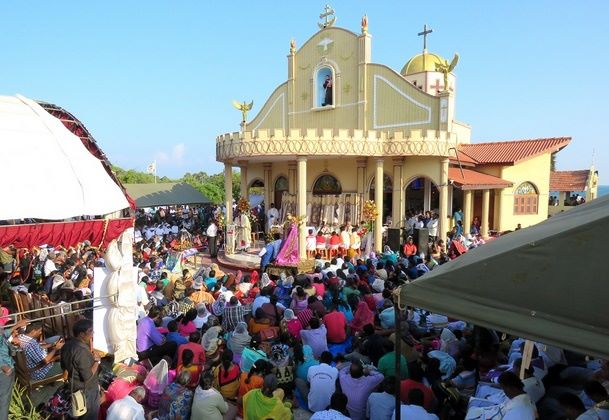Kachchatheevu island, its significance in India’s relationship with Sri Lanka
By Arnav Jha
On August 10, during the course of his speech in Parliament for the no-confidence debate, Prime Minister Narendra Modi made mention of the island of Kachchatheevuin response to the now-expunged remarks made by opposition member Rahul Gandhi. In his remarks, the PM noted that it was Congress that was in power when the island was given over to neighbouring Sri Lanka, stating “Kachchatheevuis an island between Tamil Nadu and Sri Lanka. Somebody gave it to another country. It happened under the leadership of Indira Gandhi.”
He also mentioned that the DMK (Dravida Munnetra Kazhagam) government in Tamil Nadu continues to write to him frequently, asking him to take back the island from Sri Lanka. It was reported that the last such request from the DMK government came ahead of the recent visit of the Sri Lankan President Ranil Wickremesinghe, with Tamil Nadu Chief Minister M. K. Stalin stating in his letter that “The transfer of Kachchatheevu to Sri Lanka, by the Union government, without the state government’s consent, has deprived Tamil Nadu fishermen’s rights and adversely impacted their livelihood.”
History of the island
Kachchatheevu is an uninhabited island in the Palk Strait between India and Sri Lanka which was formed due to volcanic eruptions as recently as the 14th century. It lies 33 km from the Indian coast, northeast of the town of Rameswaram in Tamil Nadu. The 285-acre (roughly 1.15 sq km) island was originally part of the Jaffna Kingdom in Sri Lanka before passing on to the Ramnad Kingdom in India which later came to be under the Madras Presidency during the British Raj. While both Indian and Sri Lankan sides vied for possession of the island under the British Raj, post-independence, the island was claimed by India in its entirety though surveys from Sri Lanka continued to show otherwise.
This issue would only reach some kind of conclusion in 1974 under the reign of the then-Indian PM Indira Gandhi who decided to use the island to settle longstanding maritime disputes between the two neighbouring countries. At the time it was assumed that holding on to the island held little strategic value and it was not eminently suited for extended human habitation either. This presumably made the island a cheap price for settling disputes between the two nations.
Thus, in a series of agreements signed between the Indira Gandhi government and Srimavo Bandaranaike from 1974-76, Kachchatheevu was ceded to Sri Lanka with the attached guarantee that Indian fisherman would continue to have access to it though the exact nature of this access was never clarified.
Ever since the Tamil Nadu government has continued to claim that the deal was made without its express consent and that it has been harmful to the fishermen of the state. In 1991, a resolution was adopted by the Tamil Nadu Assembly to demand a return of the island.
In 2008, then Chief Minister of the state Jayalalithaa even moved the Supreme Court in an endeavour to nullify the agreements that handed over the island to Sri Lanka.
Why it remains a factor in New Delhi-Colombo ties
While it is true that the island is more or less uninhabited, its possession by either side is not a simple matter of pride. The island is significant for two reasons. First, there is a large 20th-century Catholic church on the island known as St Anthony’s church that is significant for communities on both the Indian and Sri Lankan side. Every year, thousands of Indians make their way to Kachchatheevu for an annual festival, which is celebrated by both communities.
The second reason is that the island and its waters are teeming with marine resources and before India and Sri Lanka drew up their maritime borders, it was common for fishermen from both sides to fish in its waters and use the island to rest and tend to their nets.
After the series of agreements between1974-1976, Indian fishermen were still allowed to access the island for resting, tending to their nets and visiting the aforementioned church but they were no longer allowed to fish around the island.
It is important to note here that while a 1976 treaty did prohibit fishermen from either side from operating in the exclusive economic zones of the other side, Kachchatheevu lies at the edge of the EEZs of both nations, confusing the matter with regard to fishing rights.
Nevertheless, Indian fishermen, seeking new grounds, continued to fish in Sri Lankan waters, including those of Kachchatheevu. While there were no repercussions for this during the decades of the Sri Lankan civil war, post-2009, Colombo started aggressively manning its sides of the claimed maritime border, leading to the arrests of several Indian fishermen at the hands of the Sri Lankan coastguard.
With each arrest and period of tension between the two sides, the demand for the return of Kachchatheevu was revived though the Centre has maintained all throughout that there is no real legal remedy to bring about its return given that it was explicitly handed over by the Indian side in the treaties between 1974-1976.
That said, the ambiguity of the fishing rights issue in the waters of Kachchatheevu may still be resolved to the satisfaction of Tamil Nadu’s fishermen but this would require the cooperation of the Sri Lankan side.
-news9live.com



Comments are closed, but trackbacks and pingbacks are open.